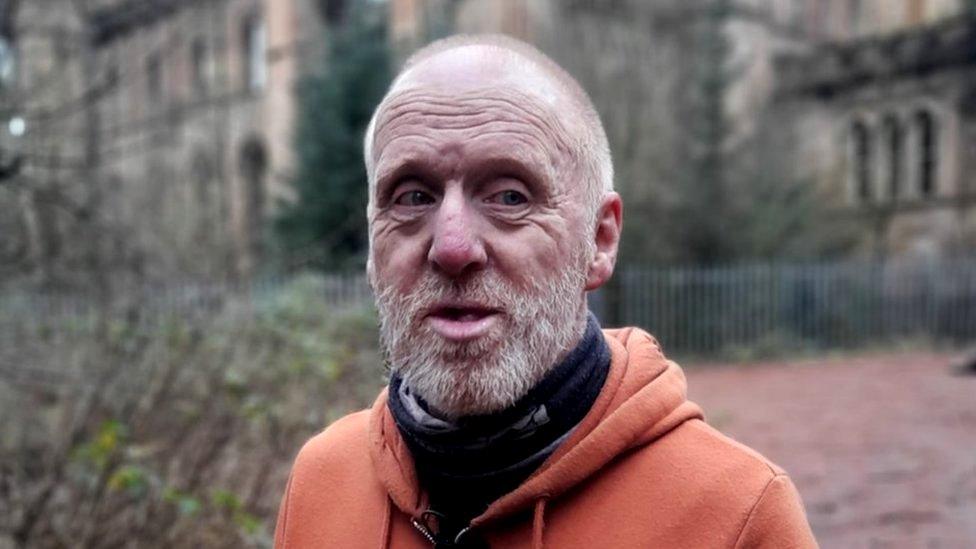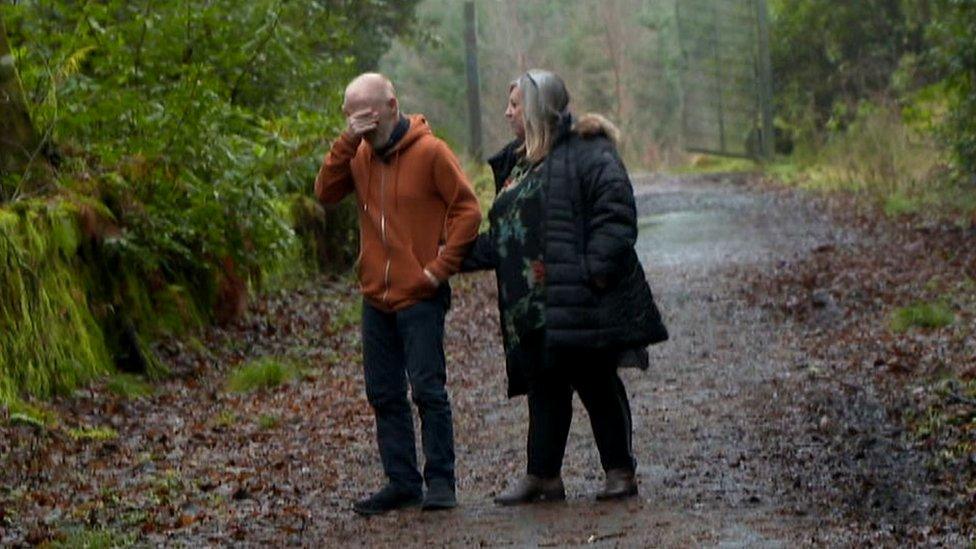The shameful legacy of the Lennox Castle hospital
- Published

Lennox Castle was the site of the hospital for "mentally deficient" people until it closed in 2002
A lot has changed since Scotland closed its largest institution for people with learning disabilities 20 years ago but, for some, its shameful legacy lives on.
Lennox Castle itself was built in the 1830s but it was not until a century later that it opened as Glasgow corporation's hospital for "mentally deficient" people.
It sprawled over many acres of the Campsie foothills and had 20 separate blocks housing 60 men and women each, about 1,200 people in total - and the castle itself was converted into a nurses' home.
When it opened in 1936, it was heralded as ahead of its time and the largest and best-equipped hospital of its kind in the UK.
However, by the 1980s standards had deteriorated to the extent that a study by the British Medical Journal found residents to be dangerously underweight and malnourished.
The hospital's medical director, Alasdair Sim, said in 1986 he had "never worked in a worse pit".

Hughie McIntyre spent 16 years in Lennox Castle and he never knew why
It was during this time Hughie McIntyre was a confused teenager wondering what he had done to deserve being put into Lennox Castle.
Hughie was adopted as a baby but later his adoptive parents sent him to Lennox Castle and he never saw them again.
"I didn't know why I was there, or what I did to deserve this," he says. "No-one came to see me. I had no family or friends."
Hughie says he had no idea how he would ever be let out of the hospital.
I met Hughie and former mental health nurse Frances Brown at the ruins of Lennox Castle just before Christmas.
The road doesn't take you all the way to the castle any more. It is a mile walk uphill, past Celtic FC's training ground into a high-walled driveway.
Rounding the corner, Hughie got his first glimpse of the castle for 25 years. He stopped and held his head in his hands.

Hughie returns to the castle for the first time in 25 years
"I was in there for 16 years," he says. "I lost the will to survive. It's scary coming back into this place.
"I remembered my life in there. I was tortured: beaten, kicked, heavily punched and I had severe injuries. I get nightmares thinking about it."
Hughie had little privacy in the hospital, and rules were strict.
"They let you out, but you had to be back in the ward for eight o'clock at night," he says.
"Then you've got to remain in your bed until the staff come on duty. And the staff don't tap you to wake you up, they grab the bottom of the bed and start bouncing the bed up and down to get you up.
"When you're up, you stand at the bottom edge of the bed until you get a headcount. And if you're not in the ward, they'll go out looking for you."
'Kept hitting me'
Hughie says he did run away but was caught and dragged back to the ward.
"They kept hitting me and hitting me," he says. "I couldn't bear it."
It was only once the hospital was in the process of being de-commissioned in the late 90s, Hughie found he had a shot at leaving.
He met Frances Brown, a former mental health nurse, who had spent several weeks at Lennox Castle as part of her training.

Frances Brown spent some of her training at Lennox Castle
She says: "It was probably the worst experience of my professional career and probably my life.
"I remember how badly it affected me. People were just not treated as human."
During the late 90s, social care was in the process of a radical transformation.
Institutions such as Lennox Castle were out of favour and care in the community was in.
The Scottish government recognised that holding people in these large institutions was not helping the very people it was intended to. They had to close.
Although care in the community was associated with an amount of scaremongering, its purpose was to listen to the needs of the person, and get what they needed to live as a member of their community.
Years later, Frances returned to Lennox Castle to help in the decommissioning process.
She says: "I'll never forget the day I came back, the cold sweat that came over me coming up the driveway again, just remembering all of that emotion and feelings and things I was feeling here, and I was the person who was able to go home at night."

Dr Sam Smith was involved in helping residents establish what they needed to move on
Dr Sam Smith was also involved in helping residents establish what they needed to move on from being an inpatient to being a productive part of society.
She says: "I thought what we were doing when we were closing the hospital was not just helping those people who lived there move out, but we were also ensuring the other families and individuals didn't have places like Lennox Castle as the only choice available if things got difficult."
NHS Greater Glasgow and Clyde told the BBC that Lennox Castle was closed in April 2002 as it was recognised that institutional care it provided was "outdated and did not support a good quality of life".
It said: "In the early 1990s the health board actively developed a resettlement programme with partner councils and support providers to ensure that people living in Lennox Castle were supported to live in their own homes in their own communities.
"The health board funded housing associations to purchase suitable housing and transferred funds to local councils to provide the care and support needed."
Dr Smith says the large institutions may have closed, but she feels there's still much to learn about how people with learning difficulties are supported.
"We need to do better," she says.
"All the potential lessons that could have been learned from the process of decommissioning the institutions haven't really been taken on board as well as they could.
"We could do so much better than we are."
Institutionalised homelessness
Local authorities are still placing people with learning disabilities and autism in hospitals, and assessment/treatment centres that may not be in their area.
Frances Brown says it is a form of institutionalised homelessness.
"People are being evicted from their communities into these institutions, and having their lives taken away from them," she says.
A 2018 report by the Scottish government found that more than 700 people with learning difficulties and autism were in out-of-area care.
About 200 of them had been inpatients for more than a decade and another 70 had been in hospitals for more than five years.
Frances says getting proper care for people with learning disabilities has been her life's work.
"It's really sad we're still arguing and fighting every day to stop these things happening and help everybody lead a fulfilling life," she says.
The ruins of Lennox Castle cast a haunting shadow on the landscape and our social history.
Though the institution gone, its past remains deeply embedded in the memories of patients and staff brave enough to share their experiences to help shape a better future for social care.